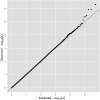Genome-wide association analysis of body mass in chronic obstructive pulmonary disease
- PMID: 21037115
- PMCID: PMC3266061
- DOI: 10.1165/rcmb.2010-0294OC
Genome-wide association analysis of body mass in chronic obstructive pulmonary disease
Abstract
Cachexia, whether assessed by body mass index (BMI) or fat-free mass index (FFMI), affects a significant proportion of patients with chronic obstructive pulmonary disease (COPD), and is an independent risk factor for increased mortality, increased emphysema, and more severe airflow obstruction. The variable development of cachexia among patients with COPD suggests a role for genetic susceptibility. The objective of the present study was to determine genetic susceptibility loci involved in the development of low BMI and FFMI in subjects with COPD. A genome-wide association study (GWAS) of BMI was conducted in three independent cohorts of European descent with Global Initiative for Chronic Obstructive Lung Disease stage II or higher COPD: Evaluation of COPD Longitudinally to Identify Predictive Surrogate End-Points (ECLIPSE; n = 1,734); Norway-Bergen cohort (n = 851); and a subset of subjects from the National Emphysema Treatment Trial (NETT; n = 365). A genome-wide association of FFMI was conducted in two of the cohorts (ECLIPSE and Norway). In the combined analyses, a significant association was found between rs8050136, located in the first intron of the fat mass and obesity-associated (FTO) gene, and BMI (P = 4.97 × 10(-7)) and FFMI (P = 1.19 × 10(-7)). We replicated the association in a fourth, independent cohort consisting of 502 subjects with COPD from COPDGene (P = 6 × 10(-3)). Within the largest contributing cohort of our analysis, lung function, as assessed by forced expiratory volume at 1 second, varied significantly by FTO genotype. Our analysis suggests a potential role for the FTO locus in the determination of anthropomorphic measures associated with COPD.
Figures


Similar articles
-
A Genome-Wide Association Study of Emphysema and Airway Quantitative Imaging Phenotypes.Am J Respir Crit Care Med. 2015 Sep 1;192(5):559-69. doi: 10.1164/rccm.201501-0148OC. Am J Respir Crit Care Med. 2015. PMID: 26030696 Free PMC article.
-
Examining the Effects of Age on Health Outcomes of Chronic Obstructive Pulmonary Disease: Results From the Genetic Epidemiology of Chronic Obstructive Pulmonary Disease Study and Evaluation of Chronic Obstructive Pulmonary Disease Longitudinally to Identify Predictive Surrogate Endpoints Cohorts.J Am Med Dir Assoc. 2017 Dec 1;18(12):1063-1068. doi: 10.1016/j.jamda.2017.09.028. J Am Med Dir Assoc. 2017. PMID: 29169736 Free PMC article.
-
A genome-wide association study in chronic obstructive pulmonary disease (COPD): identification of two major susceptibility loci.PLoS Genet. 2009 Mar;5(3):e1000421. doi: 10.1371/journal.pgen.1000421. Epub 2009 Mar 20. PLoS Genet. 2009. PMID: 19300482 Free PMC article.
-
Genetic Advances in Chronic Obstructive Pulmonary Disease. Insights from COPDGene.Am J Respir Crit Care Med. 2019 Sep 15;200(6):677-690. doi: 10.1164/rccm.201808-1455SO. Am J Respir Crit Care Med. 2019. PMID: 30908940 Free PMC article. Review.
-
Lessons from ECLIPSE: a review of COPD biomarkers.Thorax. 2014 Jul;69(7):666-72. doi: 10.1136/thoraxjnl-2013-204778. Epub 2013 Dec 5. Thorax. 2014. PMID: 24310110 Review.
Cited by
-
A functional variant alters binding of activating protein 1 regulating expression of FGF7 gene associated with chronic obstructive pulmonary disease.BMC Med Genet. 2019 Feb 18;20(1):33. doi: 10.1186/s12881-019-0761-7. BMC Med Genet. 2019. PMID: 30777021 Free PMC article.
-
Defining COPD-Related Comorbidities, 2004-2014.Chronic Obstr Pulm Dis. 2014 May 6;1(1):51-63. doi: 10.15326/jcopdf.1.1.2014.0119. Chronic Obstr Pulm Dis. 2014. PMID: 28848811 Free PMC article. Review.
-
BMI trajectory in adulthood in relation to all-cause and cause-specific mortality: A retrospective cohort study in Taiwan.PLoS One. 2023 Dec 20;18(12):e0295919. doi: 10.1371/journal.pone.0295919. eCollection 2023. PLoS One. 2023. PMID: 38117791 Free PMC article.
-
Replication of 6 obesity genes in a meta-analysis of genome-wide association studies from diverse ancestries.PLoS One. 2014 May 30;9(5):e96149. doi: 10.1371/journal.pone.0096149. eCollection 2014. PLoS One. 2014. PMID: 24879436 Free PMC article.
-
Paradigms in chronic obstructive pulmonary disease: phenotypes, immunobiology, and therapy with a focus on vascular disease.J Investig Med. 2017 Aug;65(6):953-963. doi: 10.1136/jim-2016-000358. Epub 2017 Mar 3. J Investig Med. 2017. PMID: 28258130 Free PMC article. Review.
References
-
- Celli BR, Cote CG, Marin JM, Casanova C, Montes de Oca M, Mendez RA, Pinto Plata V, Cabral HJ. The body-mass index, airflow obstruction, dyspnea, and exercise capacity index in chronic obstructive pulmonary disease. N Engl J Med 2004;350:1005–1012. - PubMed
-
- Landbo C, Prescott E, Lange P, Vestbo J, Almdal TP. Prognostic value of nutritional status in chronic obstructive pulmonary disease. Am J Respir Crit Care Med 1999;160:1856–1861. - PubMed
-
- Schols AM, Slangen J, Volovics L, Wouters EF. Weight loss is a reversible factor in the prognosis of chronic obstructive pulmonary disease. Am J Respir Crit Care Med 1998;157:1791–1797. - PubMed
-
- Vestbo J, Prescott E, Almdal T, Dahl M, Nordestgaard BG, Andersen T, Sorensen TI, Lange P. Body mass, fat-free body mass, and prognosis in patients with chronic obstructive pulmonary disease from a random population sample: findings from the Copenhagen City Heart Study. Am J Respir Crit Care Med 2006;173:79–83. - PubMed
-
- Mair G, Miller JJ, McAllister D, Maclay J, Connell M, Murchison JT, MacNee W. Computed tomographic emphysema distribution: relationship to clinical features in a cohort of smokers. Eur Respir J 2009;33:536–542. - PubMed
Publication types
MeSH terms
Substances
Grants and funding
- N01HR76113/HR/NHLBI NIH HHS/United States
- N01HR76104/HR/NHLBI NIH HHS/United States
- N01HR76105/HR/NHLBI NIH HHS/United States
- U01 HL089897/HL/NHLBI NIH HHS/United States
- T32HL007427/HL/NHLBI NIH HHS/United States
- N01HR76110/HR/NHLBI NIH HHS/United States
- R01 HL084323/HL/NHLBI NIH HHS/United States
- N01HR76106/HR/NHLBI NIH HHS/United States
- N01HR76109/HR/NHLBI NIH HHS/United States
- N01HR76116/HR/NHLBI NIH HHS/United States
- N01HR76112/HR/NHLBI NIH HHS/United States
- R01 HL083069/HL/NHLBI NIH HHS/United States
- N01HR76107/HR/NHLBI NIH HHS/United States
- N01HR76102/HR/NHLBI NIH HHS/United States
- N01HR76118/HR/NHLBI NIH HHS/United States
- N01HR76115/HR/NHLBI NIH HHS/United States
- N01HR76111/HR/NHLBI NIH HHS/United States
- N01HR76114/HR/NHLBI NIH HHS/United States
- N01HR76103/HR/NHLBI NIH HHS/United States
- R01 HL075478/HL/NHLBI NIH HHS/United States
- U01 HL089856/HL/NHLBI NIH HHS/United States
- N01HR76108/HR/NHLBI NIH HHS/United States
- G0500306/MRC_/Medical Research Council/United Kingdom
- N01HR76101/HR/NHLBI NIH HHS/United States
LinkOut - more resources
Full Text Sources
Medical

